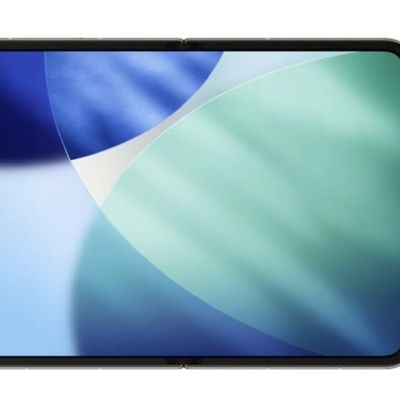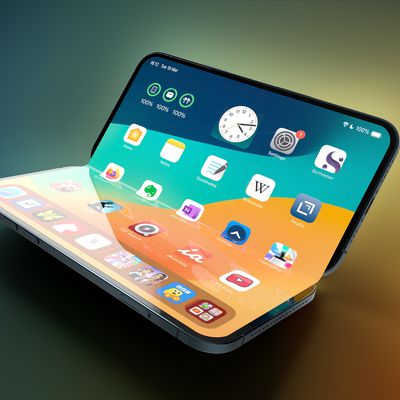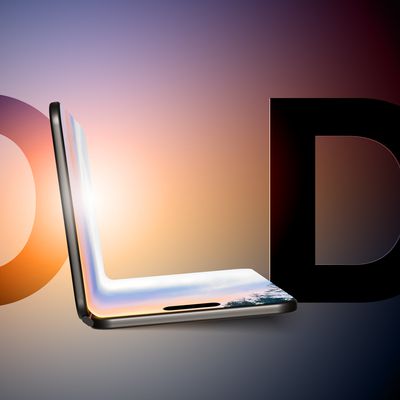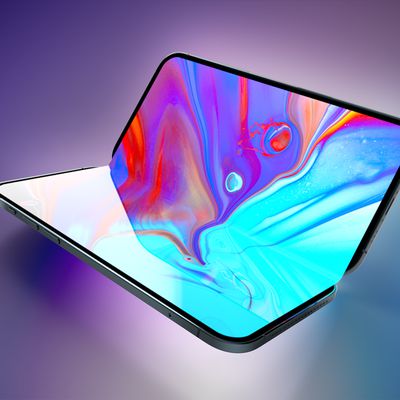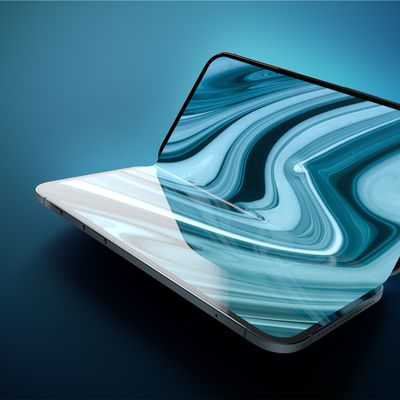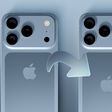Apple has been working on a foldable iPhone for multiple years now, and we've been hearing rumors for more than a decade. Information is ramping up, and it looks like we could see Apple release its first foldable iPhone in fall 2026.
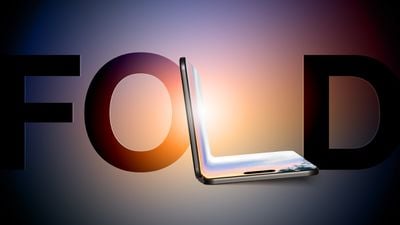
What Will Apple's Foldable iPhone Look Like?
Apple has tested multiple fold styles and device sizes, including one with a clamshell design that would be similar in size to a current iPhone that folds in half vertically, and a book-like design that folds horizontally and opens up to a larger iPad mini-sized display.
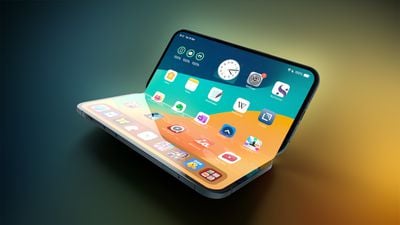
In 2024, it was sounding like Apple would go with the clamshell design because it was testing prototypes in that style, but more recent rumors are solidifying around a book-like design. With the book style, the iPhone would have an outer display and camera that can be used when it's closed, and then a larger, inner display that offers up much more screen space to work with.

The foldable iPhone could have a titanium alloy casing with a hinge made from stainless steel and titanium with liquid metal components, and there could be a dual-lens rear camera along with a single front-facing camera.
Apple analyst Ming-Chi Kuo believes that Apple might not opt for Face ID, instead installing a Touch ID side button. It's possible that would allow Apple to save valuable real estate inside to keep the device as thin as possible, but it would be a definite change as Apple just eliminated Touch ID from the iPhone lineup with the launch of the iPhone 16e.
Apple will need to overhaul iOS to be able to better transition from a small display to a larger display, but luckily iPadOS already exists. The foldable iPhone will allegedly have a display with a 4:3 aspect ratio, much like the iPad.
Foldable iPhone Size
Current rumors suggest that the foldable iPhone will feature a display that's around 5.5 inches when it's folded in half, and a 7.8-inch display when it's opened up.
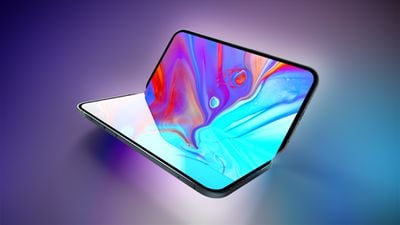
It could be as thin as 4.5mm when it is unfolded, and 9mm to 9.5mm when it is closed. If it is 4.5mm, when open, the foldable iPhone will be Apple's thinnest device by far. That title is currently held by the 12.9-inch iPad Pro, which is 5.1mm thick.
One analyst, Jeff Pu, believes Apple could be working on not one, but two foldable iPhones, in different 7.9-inch and 8.3-inch sizes. There isn't too much difference in between those two sizes though, so Apple could opt to just select a single display size.
According to one leaker, the inner (unfolded) display will measure in at 7.76 inches with a 2,713 x 1,920 resolution, while the outer display (folded) will measure in at 5.49 inches with a 2,088 x 1,422 resolution and a 4:3 aspect ratio. Another leaker has suggested it will have a 7.6-inch display size when unfolded.
Eliminating the Crease
The 2026 foldable iPhone reportedly has no visible crease, a problem that affects most foldable devices on the market. Apple is said to have pursued eliminating the crease "regardless of cost," and the company has developed a "new material property" that makes the crease disappear. The crease has been described as "nearly invisible" when the iPhone is unfolded.

One of the reasons that Apple waited so long to release a foldable iPhone is because it struggled to make a device that did not have a visible crease, but it may be a problem that has now been largely solved given the uptick in rumors.
Apple is planning to use ultra-thin glass for the foldable iPhone, and Chinese manufacturer Lens Technology could be Apple's primary glass supplier. Corning is likely to provide the raw materials to Lens Technology, with Apple choosing the supplier because of its expertise in glass strengthening and minimizing side cracks after cutting.
The foldable iPhone will use a new type of display panel created by Samsung, using a custom display process that Apple has the trademark for. The process includes integrating touch sensors directly into the display panel, reducing overall thickness by approximately 19 percent.
The engineering advancement brings a lighter build and a more rigid display structure, and the display meets Apple's requirements for thinness, power efficiency, and brightness.
The outer display of the foldable iPhone (which you see when it is folded) could have a hole-punch camera, while the inner display will feature an under-display camera.
The Foldable iPhone Hinge
To minimize the crease in the display, Apple plans to use liquid metal for the iPhone's hinge, which will improve durability. This is one technique that might allow Apple to get rid of the crease that has plagued other foldable smartphones. Apple's hinge will be higher quality than hinges used for other foldable smartphones.
Liquid metal, or amorphous metal, has a structure that is more resistant to bending, deformation, and denting than traditional metal. Its properties are derived from the manufacturing method, which involves rapid heating and cooling. Its structure makes it tougher than titanium alloy, and it has a stainless steel look.
Apple may also use a combination of titanium and stainless steel for the hinge.
Foldable iPhone Cameras
The foldable iPhone could have an under-display camera for the interior of the device, with a single hole punch camera for the exterior when it's folded up. The under-display camera is not expected to feature Face ID.
The foldable iPhone rear camera setup will have a Main lens and an Ultra Wide lens with no Telephoto lens. Rumors suggest that both lenses will be 48 megapixels, which isn't too surprising because current iPhone models have 48-megapixel lenses.
A20 Chip
The foldable iPhone will use Apple's A20 chip, built on TSMC's 2nm process.
The transition to 2nm will allow for more transistors in each chip, which will boost performance. The A20 chips could be up to 15 percent faster and 30 percent more efficient than A19 chips. Apple is also expected to use TSMC's Wafer-Level Multi-Chip Module (WMCM) chip packaging technology. WMCM will see RAM directly integrated on the chip's water with the CPU, GPU, and Neural Engine.
Incorporating RAM this way could bring faster performance for overall tasks and Apple Intelligence, better thermal management, and improved Apple Intelligence.
Battery
Apple worked to increase the power efficiency of its first foldable display in an effort to maximize battery life, and rumors suggest that the foldable iPhone will have decent battery life despite a thin size. Apple reduced the display driver integrated circuit (IC) from 28nm to 16nm, which is a notable improvement.
Pricing
Apple's first foldable iPhone could cost nearly twice as much as the iPhone 16 Pro Max.
Apple analyst Ming-Chi Kuo believes that Apple's foldable iPhone will be priced somewhere between $2,000 and $2,500, and Bloomberg's Mark Gurman has also suggested a similar price range.
Rumor History
The first hints of a foldable iPhone surfaced in 2016 when rumors suggested LG Display would be mass producing foldable displays for smartphones in 2018 and supplying them to companies like Apple and Google, but LG clearly did not end up supplying foldable displays to Apple at that time because no folding iPhone materialized.
A 2017 rumor kept the folding iPhone concept alive, indicating Apple was partnering up with LG to develop an iPhone with a foldable display. LG has a number of foldable display prototypes that use flexible OLED panels, including one that folds over like a book and a second that rolls up like a newspaper, and LG has been refining its technology every year.
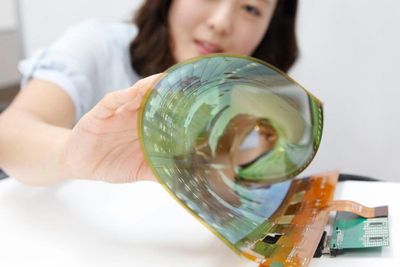
Rumors in 2019 suggested that Samsung offered to supply foldable displays to Apple, and Apple supplier Corning was rumored to be working on a foldable glass solution that Apple might adopt.
In September 2020, rumors indicated that Samsung was providing foldable display samples to Apple for a future foldable iPhone, but years later, there is no indication that Apple is planning to use Samsung's technology.
Apple analyst Ming-Chi Kuo, who often has reliable insight into Apple's plans, said in 2021 that development on a foldable iPhone had not yet kicked off, but he later claimed that Apple experimented with an 8-inch foldable iPhone with a flexible OLED display and a 9-inch foldable device.
In 2021, Bloomberg claimed that Apple had started "early work" on an iPhone with a foldable display, but that it had not committed to releasing a foldable device at that time. Development in 2021 had not expanded beyond a display, and Apple did not have full foldable iPhone prototypes.
In 2024, The Information said that Apple built two foldable iPhone prototypes with a clamshell design that folds widthwise, but we didn't hear much else about it.
This year, foldable iPhone discussion picked up with Kuo suggesting that Apple was working on a book-style foldable iPhone that could be released at the end of 2026 or in early 2027.
Foldable iPhone Patents
Apple patents all kinds of things that never become finished products so patents aren't necessarily a reliable way to predict what's in development, but Apple has a few foldable iPhone patents.
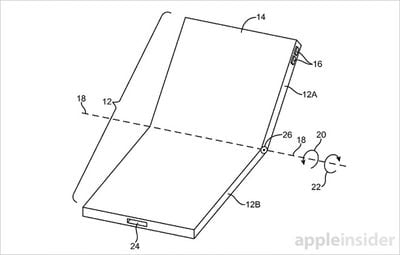
Apple's first foldable iPhone patent surfaced in 2016, describing a smartphone that folds in half horizontally using a flexible OLED display and a hinged metal support structure. Both halves of the display remain accessible when the phone is shut, and there are also drawings depicting devices with multiple folds.

A 2019 patent application describes foldable smartphone with a built-in heating element or display heating feature to cut down on failures at the fold in cold temperatures, a problem that has the potential to impact foldable smartphones.
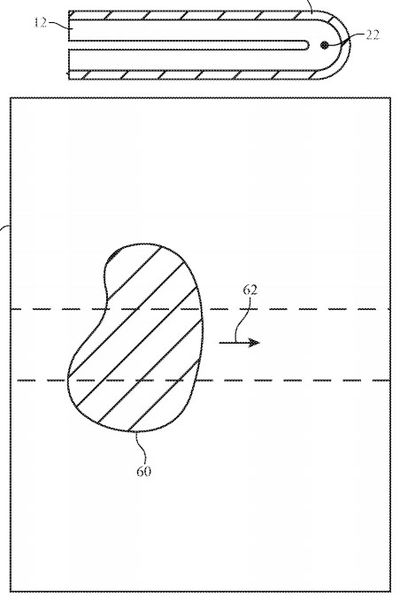
Apple in February 2020 was granted a patent for a foldable device with a hinge mechanism that utilizes movable flaps to help prevent the display from being creased or damaged when folded.
The hinge mechanism is designed to ensure adequate separation between the first and second parts of the display. When the device is unfolded, movable flaps extend to cover the gap, and then retract when the device is folded.
An Apple patent granted in March describes a unique alternative to a foldable iPhone, explaining a system that would allow two or more devices to act as one when brought close to each other through the use of proximity sensors.
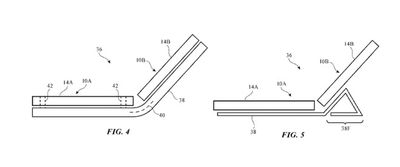
The patent envisions two separate devices that automatically detect one another when placed together with a shared display. The wording of the patent seems to suggest that Apple could create a single bendable device comprised of two displays in seamless communication with each other.
A 2020 patent filing suggests Apple is exploring a protective layer for a foldable iPhone that would resist cracking. The iPhone would feature a hardcoat layer that would fill pre-existing micro-cracks to make it harder for a larger crack to appear.
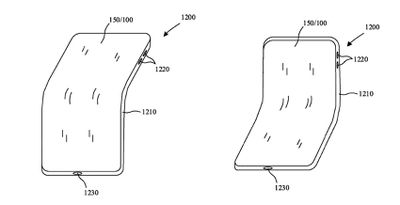
The extra layer would be placed directly on top of the display and would resist punctures and scratches.
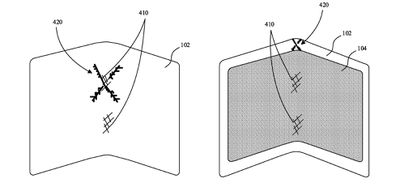
Apple's Competition
Samsung unveiled its first foldable smartphone way back in 2019, and has continued releasing new models every year since then. Other companies like Google, LG, Motorola, and Huawei have also followed in Samsung's footsteps, so there are multiple Android-based foldable smartphones to choose from.
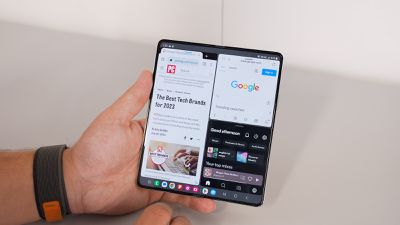 Galaxy Z Fold 5
Galaxy Z Fold 5Samsung makes its foldable smartphones two ways, with the phone-to-tablet Galaxy Fold that opens like a book, and the smaller flip-up Galaxy Flip Z.
Most foldables on the market have the book-style folding mechanism, and as Apple waits to debut a foldable device, Android smartphone makers are getting better and better at hinges, crease-free foldable displays, and more. Samsung is on its sixth-generation foldables.
 Galaxy Z Flip
Galaxy Z FlipNo foldable is perfect as of yet and there are still some issues with pricing and durability, but Android device makers definitely have an edge over Apple at this point.
When Will Apple Launch a Foldable iPhone?
According to The Wall Street Journal, Apple is aiming to introduce a foldable iPhone in 2026 or 2027. The iPhone could be Apple's first foldable, with a MacBook/iPad with a 19-inch display slated for launch later.
Apple analyst Ming-Chi Kuo believes Apple's first foldable iPhone will come in late 2026, alongside iPhone 18 Pro, iPhone 18 Pro Max, and iPhone 18 Air devices.
Analyst Jeff Pu believes that a foldable iPhone could come out as soon as late 2026, while TrendForce believes it will come in 2027. The Information says that Apple could release a foldable iPhone as soon as 2026.
Other Foldable Apple Devices
Along with a foldable iPhone, rumors suggest that Apple is exploring other foldable devices, including iPads and MacBooks that have foldable OLED displays. Initial rumors suggested that Apple would unveil a foldable iPad or Mac before a foldable iPhone, but now it sounds like the foldable iPhone is coming first.
Apple's Second Foldable iPhone
After Apple launches its first foldable iPhone in late 2026, it will introduce a second-generation model in 2027. The 2027 foldable iPhone will fall on the 20th anniversary of the iPhone's launch.
Guide Feedback
Have questions or feedback on our foldable iPhone guide? Send us an email here.


